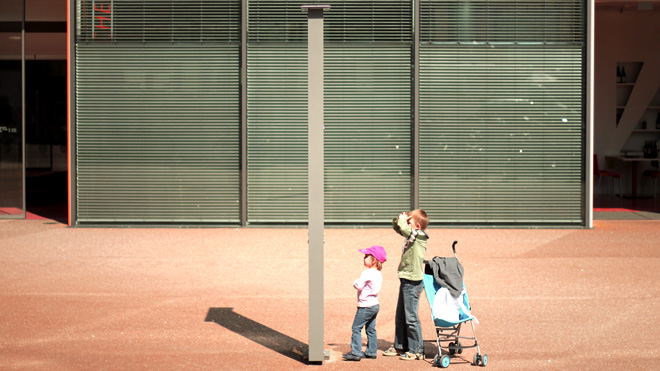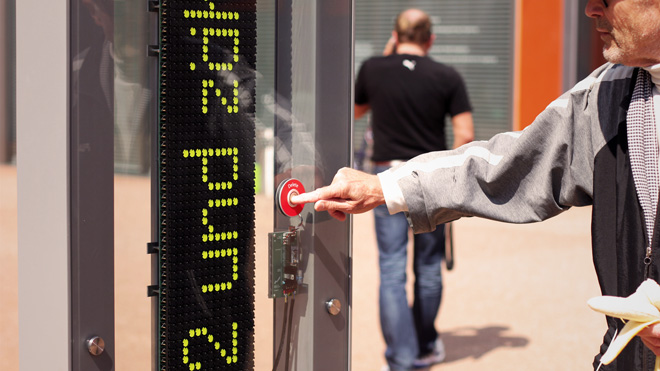Gofor proports to be a San Francisco startup building the future of consumer drone technology. As a design fiction – this is great
Gofor proports to be a San Francisco startup building the future of consumer drone technology. As a design fiction – this is great
Gawker Media – publishers of Gawker, Jezebel, and a host of other blogs – has an awesome “big data” Big Board which is available online and also installed in their office (above). Nick Denton has always been obsessed with metrics, and I applaud this level of introspection. The Big Board tracks the usual metrics, but also has other intriguing stats they are interested in:
Also interesting: the Big Board isn’t optimized for mobile viewing (at least on my iPhone 4s). I would assume that this will change soon.
The internets are ablaze – mostly with scorn – over two different planned communities which have attracted attention after the Newtown, CT shooting: the Citadel and Glenn Beck’s Independence USA. The former is planned to:
…house between 3,500 and 7,000 patriotic American families who agree that being prepared for the emergencies of life and being proficient with the American icon of Liberty — the Rifle — are prudent measures. There will be no HOA (ed – Home Owner’s Association). There will be no recycling police and no local ordinance enforcers from City Hall.
While Independence, USA would combine Disney World with what appears to be Celebration, FL (also by Disney):
While Independence is very much a dream at this point, the proposed city-theme park hybrid would bring several of Glenn’s seemingly disconnected projects into one place. Media, live events, small business stores, educational projects, charity, entertainment, news, information, and technology R&D – all of these things would have a home in Independence. With the rest of the country and the world going away from the values of freedom, responsibility and truth, Independence would be a place built on the very foundation of those principles. A retreat from the world where entrepreneurs, artists, and creators could come to put their ideas to work. A place for families to bring their children to be inspired.
Some may scorn, but I say: more power to you.
America has a great and rich history of groups of people coming together to found communities which share their combined values. The various Shakertown’s – such as Pleasant Hill, Kentucky – which dot Pennsylvania, Ohio and Kentucky are but one example of 19th Century utopia settlements founded by the Religious Society of Friends. Another great one is New Harmony, Indiana founded by a pietist, communal German religious group, known as Harmonists, Harmonites or Rappites in 1814. The Village of Mariemont, Ohio is a suburb of Cincinnati and was built in the 1920s by Mary Emery and exhibits English architecture from Norman to classic Georgian style. And you can’t forget any contemporary suburban gated community. Americans just love to build these things.
That isn’t to say these experiments are a always success. Only one or two Shakers remain alive today (since as part of their religion they decided not to procreate), and the Harmonists were really a band of indentured servants for leader George Rapp; who eventually sold New Harmony to move back to Pennsylvania. Mariemont is still a pretty little suburban town, and well, Trayvon Martin.
What is interesting in many of these cases, is the perceived need to isolate the group from the “other” in order to maintain discipline, security, or order. Also unsurprising, is the retro and nostalgic tone of both developments: both look to old Germanic town centers, and in the Citadel’s case explicitly showcase Rothenburg, Germany:
What is objectionable about the Citadel is their total lack of being prepared to run a corporation (which a town is): they claim to require no credit check, no background check, zero down payment, zero interest, and zero property taxes. This is not a way to operate a going concern, even if you want to maintain “Liberty-driven freedom derived by Thomas Jefferson’s Rightful Liberty.”
Services cost money, and people are greedy, lazy, and willing to look the other way. If you want to see what a libertarian playground would look like, head over to Gurgaon, outside New Delhi, India:
In this city that barely existed two decades ago, there are 26 shopping malls, seven golf courses and luxury shops selling Chanel and Louis Vuitton. Mercedes-Benzes and BMWs shimmer in automobile showrooms. Apartment towers are sprouting like concrete weeds, and a futuristic commercial hub called Cyber City houses many of the world’s most respected corporations.
…
To compensate for electricity blackouts, Gurgaon’s companies and real estate developers operate massive diesel generators capable of powering small towns. No water? Drill private borewells. No public transportation? Companies employ hundreds of private buses and taxis. Worried about crime? Gurgaon has almost four times as many private security guards as police officers.
Urbanity takes shared sacrifice which extends past ideology, right into your pocketbook and your daily actions. These experiments don’t even realize this, and will fail much like the hippie communes of the 1960’s/70’s.
The NYC Department of Transportation just released a new report on how NYC’s new transportation practices – including separated bicycle tracks and dedicated bus lanes – are paying off not only with faster commutes, safer streets, but financially: Measuring the Street: New Metrics for 21st Century Streets (PDF). Locally-based businesses on 9th Ave from 23rd to 31st Streets increased their retail sales up to 49%, compared to 3% borough-wide. This is in addition to a 58% decrease in injuries to all street users. And on First and Second Avenues in Manhattan there are 47% fewer commercial vacancies (compared to 2% more borough-wide).
“These projects aren’t just about the quality of life and aesthetics,” Transportation Commissioner Janette Sadik-Khan said. “They really set the table for economic development.”
This is exactly what the complete streets view of the city should be: a holistic view in how we can make our shared streets work for all, not just cars.
Park(ing) Day famously helped people all over the world re-envision the lowly parking spot, encouraging DIY urbanists for one day each fall to transform these spaces in their cities into parks, playgrounds, pop-up cafés – anything other than their intended use. The original idea, dreamed up by San Francisco-based urban design studio Rebar, went on to become a model urban prototype. The city of San Francisco adopted the concept for its “parklet” program. And now officially sanctioned parklets are popping up everywhere, most recently 2,000 miles away in Chicago.
The Next Generation of DIY Urbanism Projects: So Much Cooler Than Parklets.

I’ve been trying to use the flip-dot system by Alfa-Zeta for the last three years, so it is nice that they have begun creating pre-assembled units. Below is a piece of art entitled Delete by lab binaer located in the Public Library of Augsburg forecourt:
A snap-shot of the online encyclopaedia Wikipedia serves as basis for this artwork. The unique copy of the constantly growing online knowledge is stored on a memory in the column surrounded by security glass. There are only two connections to the outside world: Visually the display shows a tiny part of the millions of words. Physically an alluring button wants to be pushed. But whoever pushes the button will notice that he has deleted one character permanently.


OpenPlans, a company which builds open source civic infrastructure, collaborating with the public sector to create technology for more efficient, responsive, and inclusive government, has launched a kickstarter drive to create a Transit App for iOS 6 and Beyond:
With the announcement of iOS version 6, Apple has dropped Google Maps and with it, previously built-in support for travel directions via public transit.
With your support, OpenTripPlanner Mobile, an open source application developed by OpenPlans will put transit back on the iPhone. Initially, we will offer coverage for almost all transit systems in North America (see coverage details below).
The app will also add new features that Google Maps didn’t have, allowing users to combine walking, bikes, bike-share and transit together, finding the fastest and most efficient trips regardless of mode of transportation.

Transit App will is now supporting any transit agency in North America that provides open data in the GTFS format. Hundreds of transit agencies already offer this data – check out the current coverage map.
The Chicago Neighborhoods, a project by Steve Shanabruch to brand the many different neighborhoods in Chicago:
I know branding a neighborhood is quite subjective. My experiences and knowledge are obviously different than those of someone else, especially a long-time resident, so let’s call this project “One designer’s take on Chicago.” My vision might not match yours, but I hope that we can agree that a neighborhood with a logo is better than a neighborhood without.
Check out this excellent Raja Dinkar Kelkar Museum identity redesign by Maseeh Ali Khan.
The Raja Dinkar Kelkar Museum is a one-man collection of Padmashree Late Dr. D.G. Kelkar (1896 – 1990). The museum is situated in the heart of Pune and has a collection of about 21,000 priceless artifacts, spread over an area of three floors. Upon my visit to the museum, I identified a scope of improvement within the internal communication media used such as signages, artifact descriptions and maps to guide you through. Hence, this whole new system was designed with a new visual language, identity and guidelines.